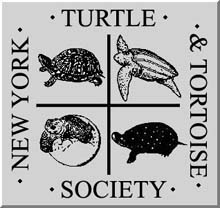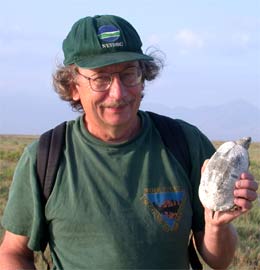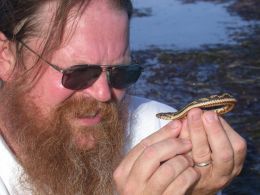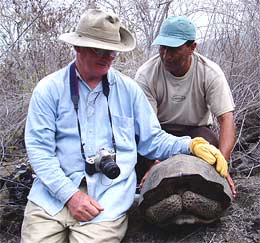 |
 |
The New York Turtle and Tortoise Society announces

Seminar 2004

Saturday, January 24, 9:00 A.M.–5:00 P.M.

The Hudson River Museum
511 Warburton Avenue
Yonkers, New York 10701
|
The New York Turtle and Tortoise Society’s seventeenth Annual Seminar will be a full-day event featuring four presentations. The fee for the day, which includes morning coffee and Danish (during the 9:00–10:00 a.m. registration check-in), is $40 per person — if you register by Friday, January 16! (The fee at the door without reservations will be $45 per person.) And those who register in advance will receive a free copy of the 494-page, 1993 Purchase Conference Proceedings! Send check, payable to NYTTS, with name, address, phone, and e-mail address, to:

NYTTS—Seminar 2003
P.O. Box 878
Orange, NJ 07051-0878
We are pleased to return to the Hudson River Museum in Yonkers, New York. Located on the bank of the Hudson River, the museum is less than 40 minutes drive or train ride from midtown Manhattan. There is ample free parking. Visit the Museum’s Web site at www.hrm.org. For driving instructions or public transportation, please visit www.hrm.org/information.html, or call 914-963-4550.
Schedule on the Metro-North Hudson Line from Grand Central Station: Depart Grand Central 8:20 a.m.; arrive Glenwood station 8:53 am. Walk one block up the hill, turn left, go one-half block and walk up through the park to the museum.
| Scheduled Program |

Al Breisch with Coahuilan box turtle
in Mexico in 2002
|
 Alvin Breisch, Reptile and Amphibian Specialist, New York State Department of Environmental Conservation, Endangered Species Unit
Alvin Breisch, Reptile and Amphibian Specialist, New York State Department of Environmental Conservation, Endangered Species Unit

“Lessons from the Amphibian and Reptile Atlas:
Where Do We Go from Here?”

In 1990, the New York State Department of Environmental Conservation
(DEC) began a ten-year atlas project to document the distribution of all amphibians and reptiles occurring in the wild in the state. The 58,000 records contributed by 1,800 volunteers included 7,150 reports of turtles. In addition to documenting distribution, important life history information, including seasonal activity, nesting and roadway mortality, was collected.
Al will discuss the 16 species of turtles native to New York and how the atlas has documented changes in their known distribution. Learn which species have declined, which species are more widespread than previously known, and which non-native species are now surviving in the wild. Of particular interest to conservationists is use of the atlas data to identify areas with high or unusual diversity of turtles and other herpetofaunal species. On the negative side, learn which species of turtles are most frequently reported as roadkills and which counties are the most dangerous for turtles that venture near roads. Expanding on the atlas data, DEC, in co-operation with DOT, Cornell University, and other colleges, is now identifying areas where turtles would benefit from “critter crossings” under roadways and what tunnel designs would be attractive to turtles. Other conservation efforts planned for the coming years include additional surveys for species that were under sampled by the atlas, radio-tracking to identify critical nesting and overwintering habitat for species at risk, and management activities to protect turtle nests.
|

George Heinrich examines a Gulf salt marsh snake in the Florida panhandle
|
 George Heinrich, Heinrich Ecological Services, St. Petersburg, Florida
George Heinrich, Heinrich Ecological Services, St. Petersburg, Florida

“Florida Turtles: Diversity and Conservation”

Florida is home to over 8% of the world's known turtle species and is a significant area for both turtle diversity and habitat. Twenty-five out of 54 (46%) of the turtle species found in the United States are also found in Florida. They are represented in upland communities, such as scrub and sandhills, in rivers, lakes, swamps and even coastal habitats, such as salt marsh, mangrove communities and marine systems. Certainly, habitat diversity and species richness makes Florida a chelonian hotspot.
Turtles are ancient creatures that walked the earth with the dinosaurs and today are important and visible elements in many ecosystems. A number of the species that occur in Florida are now in decline and in need of conservation attention. Conservation efforts on their behalf are also beneficial to the ecosystems in which they are found. Like other areas of the world, there is a strong focus on marine species. Consequently, most research and conservation dollars are spent on those high profile species.
George will focus on the diversity and conservation needs of Florida's non-marine species, with emphasis on the gopher tortoise (Gopherus polyphemus), diamondback terrapin (Malaclemys terrapin) and riverine species. In addition, the role of education in conserving these ecologically important vertebrates will be discussed. Despite the apparent urgency of the Florida situation, the opportunities for conservation remain great.
Twice co-chair of the Gopher Tortoise Council, George will discuss the work of this uplands conservation organization on behalf of this keystone species. He has also studied the ecology and conservation needs of diamondback terrapins as part of a University of North Florida research team since 1995 and will discuss the diverse conservation challenges related to this species in the Southeast.
|

Don Lewis and diamondback terrapins in the Wellfleet Bay Wildlife Sanctuary
|
 Don Lewis, Terrapin Researcher, full-time volunteer, Massachusetts Audubon Society Wellfleet Bay Wildlife Sanctuary
Don Lewis, Terrapin Researcher, full-time volunteer, Massachusetts Audubon Society Wellfleet Bay Wildlife Sanctuary

“Cape Cod Terrapin Conservation and Sea Turtle Rescues”

Terrapins: Scratching out an existence at the absolute edge of their range, terrapins of the Outer Cape serve as a signal species within our coastal environment. Mass Audubon's Wellfleet Bay Wildlife Sanctuary has conducted formal research efforts for the last 24 seasons. Due to harsh climate conditions, these terrapins are active for less than six months a year and have adapted to marginal upland nesting conditions, intense human development of their salt marsh habitat and 15-foot tidal cycles. Don will provide a quick update on these terrapins on the northernmost rim, research techniques and findings, survey initiatives on the Cape and along the South Coast off Buzzards Bay, and a newly awarded National Fish & Wildlife Foundation grant (Turtles in the Classroom) to use terrapins as a model for integrating field research into K–12 science curricula.
Sea Turtles: Every fall and early winter cold-stunned juvenile and sub-adult sea turtles strand on Cape Cod bayside beaches. This phenomenon has been documented for the last quarter century by researchers and rescuers organized by Mass Audubon. From 1979 to 2003, 1377 cold-stunned sea turtles stranded on Cape Cod beaches. Kemp's ridleys — the rarest and most critically endangered sea turtle — accounted for 77% of these strandings. Averaging in the mid teens to the high twenties throughout the 1980s, the number of cold-stunned strandings rose markedly to an average of 61 turtles in the mid 1990s. Strandings have continued to increase, reaching a 5-year average of 133 turtles a year in 2002. In recent years, the percentage of Kemp's ridleys has reached over 90%. During the summer months, Mass Audubon rescuers focus on disentangling leatherback sea turtle from lobster trap buoys and fishing weirs.
|

Peter Pritchard and expedition staff member with a Galápagos tortoise
|
 Peter C. H. Pritchard, Chelonian Research Institute, Oviedo, Florida
Peter C. H. Pritchard, Chelonian Research Institute, Oviedo, Florida

“Whatever happened to the Pinta Tortoise?
In Search of a Mate for Lonesome George”

The endemic tortoise of Pinta Island in the Galápagos was decimated by the early 19th century whalers, and the population collapsed to low level by 1848. Yet small numbers lingered on for a century or more, and in 1973 the discovery of a surviving tortoise on Pinta, quickly dubbed “Lonesome George” by the world press, thrust this previously almost unknown taxon into the global limelight.
We undertook an expedition in October 2003 and searched the island with two dozen experienced goat hunters and tortoise field staff to see if any traces of live tortoises remained on Pinta. Only skeletons and isolated bones were found, corresponding to 16 different tortoises. Study of these resulted in the development of new insight as to why tortoises never recovered naturally on Pinta despite the fact that the island was remote, rarely visited, and ecologically intact with the exception of a couple of decades with feral goats during the late 20th century.
|
|

|

![]()




